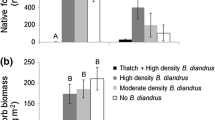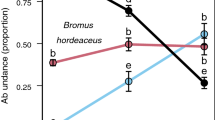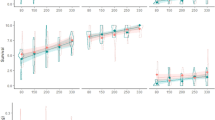Abstract
In the Northern Great Plains, invasive grasses Bromus inermis (smooth brome) and Poa pratensis (Kentucky bluegrass) are substantial threats to remnant prairies because they form monotypic stands that decrease diversity and alter nutrient cycling. A greenhouse study was conducted to evaluate the competitive ability of these two invaders and how priority effects influence competition. We grew each invasive species alone, with a conspecific neighbor, and a native neighbor (Elymus canadensis) to assess competitive ability. Priority treatments included planting both species concurrently, planting the invader prior to the native (by 21 days), and planting the native prior to the invader (by 21 days). Final aboveground biomass and a relative interaction index (RII) were used as response variables to determine the competitive ability of each species. Both competition and priority were found to have a significant effect on native and invasive species performance. Bromus inermis demonstrated a large competitive effect that increased with priority. Poa pratensis demonstrated smaller competitive effects but also benefited from priority. Unexpectedly, our native phytometer E. canadensis demonstrated a very strong competitive effect that, when coupled with priority, nearly excluded one of the invasive species.


Similar content being viewed by others
References
Abraham JK, Corbin JD, D’Antonio CM (2009) California native and exotic perennial grasses differ in their response to soil nitrogen, exotic annual grass density, and order of emergence. Plant Ecol 201:81–92
Armas C, Ordiales R, Pugnaire FI (2004) Measuring plant interactions: a new comparative index. Ecology 85(10):2682–2686
Briggs JM, Knapp AK, Blair JM, Heisler JL, Hoch GA, Lett MS, McCarron JK (2005) An ecosystem in transition: causes and consequences of the conversion of mesic grassland to shrubland. Bioscience 55(3):243–254
Cully AC, Cully JF, Hiebert RD (2003) Invasion of exotic plant species in tallgrass prairie fragments. Conserv Biol 17(4):990–998
Daehler CC (2003) Performance comparisons of co-occurring native and alien invasive plants: implications for conservation and restoration. Annu Rev Ecol Evol Syst 34(1):183–211
Damgaard C (1998) Plant competition experiments: testing hypotheses and estimating the probability of coexistence. Ecology 79:1760
Davis MA, Grime JP, Thompson K (2000) Fluctuating resources in plant communities: a general theory of invasibility. J Ecol 88(3):528–534
DeKeyser ES, Meehan M, Clambey G, Krabbenhoft K (2013) Cool season invasive grasses in Northern Great Plains. Nat Areas Nat Areas J 33:81–90
Dickson T, Hopwood J, Wilsey B (2012) Do priority effects benefit invasive plants more than native plants? an experiment with six grassland species. Biol Invas 14(12):2617–2624
Dyer AR, Rice KJ (1999) Effects of competition on resource availability and growth of a California bunchgrass. Ecology 80:2697
Goldberg DE (1987) Neighborhood competition in an old-field plant community. Ecology 68(5):1211–1223
Goldberg DE (1996) Competitive ability: definitions, contingency and correlated traits. Philos Trans R Soc Lond Ser B Biol Sci 351(1345):1377–1385
Goldberg DE, Landa K (1991) Competitive effect and response: hierarchies and correlated traits in the early stages of competition. J Ecol 79:1013–1030
Grant TA, Flanders-Wanner B, Shaffer TL, Murphy RK, Knutsen GA (2009) An emerging crisis across northern prairie refuges: prevalence of invasive plants and a plan for adaptive management. Ecol Restor 27(1):58–65
Grman E, Suding KN (2010) Within-year soil legacies contribute to strong priority effects of exotics on native California grassland communities. Restor Ecol 18(5):664–670
Hart SP, Marshall DJ (2012) Advantages and disadvantages of interference-competitive ability and resource-use efficiency when invading established communities. Oikos 121(3):396–402
Higgins JJ, Larson GE, Higgins KF (2001) Floristic comparisons of tallgrass prairie remnants managed by different land stewardships in eastern South Dakota. In: Proc. NA Prairie Conference 17: 21-31
Kueffer C, Pyšek P, Richardson DM (2013) Integrative invasion science: model systems, multi-site studies, focused meta-analysis and invasion syndromes. New Phytol 200(3):615–633
Mack RN, Simberloff D, Lonsdale WM, Evans H, Clout M, Bazzaz FA (2000) Biotic invasions: causes, epidemiology, global consequences, and control. Ecol Appl 10(3):689–710
Nernberg D, Dale MRT (1997) Competition of five native prairie grasses with Bromus inermis under three moisture regimes. Can J Bot-Rev Can Bot 75(12):2140–2145
Perkins LB, Nowak RS (2013) Invasion syndromes: hypotheses on relationships among invasive species attributes and characteristics of invaded sites. J Arid Land 5(3):275–283
Pimentel D, Zuniga R, Morrison D (2005) Update on the environmental and economic costs associated with alien-invasive species in the United States. Ecol Econ 52(3):273–288
Samson F, Knopf F (1994) Prairie conservation in North America. Bioscience 44(6):418–421
Samson FB, Knopf FL (Eds.) (1996) Prairie conservation: preserving North America’s most endangered ecosystem. Island Press
Seabloom EW, Harpole WS, Reichman O, Tilman D (2003) Invasion, competitive dominance, and resource use by exotic and native California grassland species. Proc Natl Acad Sci 100(23):13384–13389
Stevens JM, Fehmi JS (2011) Early establishment of a native grass reduces the competitive effect of a non-native grass. Restor Ecol 19(3):399–406
Vila M, Weiner J (2004) Are invasive plant species better competitors than native plant species?–evidence from pair-wise experiments. Oikos 105(2):229–238
Wainwright CE, Wolkovich EM, Cleland EE (2012) Seasonal priority effects: implications for invasion and restoration in a semi-arid system. J Appl Ecol 49(1):234–241
Williamson M (1999) Invasions. Ecography 22(1):5
Wolkovich EM, Cleland EE (2011) The phenology of plant invasions: a community ecology perspective. Front Ecol Environ 9(5):287–294
Wright CK, Wimberly MC (2013) Recent land use change in the Western Corn Belt threatens grasslands and wetlands. Proc Natl Acad Sci USA 110(10):4134–4139
Acknowledgments
Funding was provided by the South Dakota Agricultural Experiment Station and performed at SDSU Plant Science Greenhouse complex. We appreciate Dr. Carter Johnson providing resources to conduct this greenhouse experiment.
Author information
Authors and Affiliations
Corresponding author
Additional information
Communicated by S. J. Meiners.
Rights and permissions
About this article
Cite this article
Ulrich, E., Perkins, L. Bromus inermis and Elymus canadensis but not Poa pratensis demonstrate strong competitive effects and all benefit from priority. Plant Ecol 215, 1269–1275 (2014). https://doi.org/10.1007/s11258-014-0385-0
Received:
Accepted:
Published:
Issue Date:
DOI: https://doi.org/10.1007/s11258-014-0385-0




